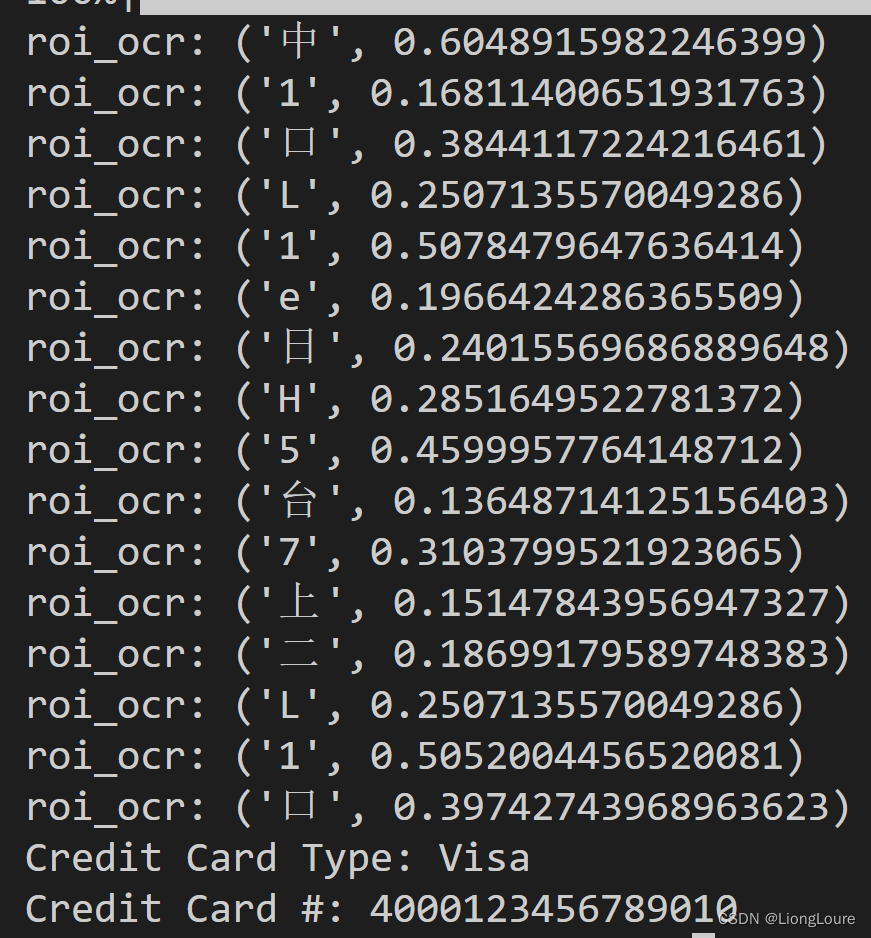本文仅供学习使用(ocr入门包,具体的文字识别需了解其他内容)
25. cnocr
安装:pip install cnocr
调用:from cnocr import CnOcr
利用cnocr进行识别的时候:
- 需要先提取目标区域,比如说车牌识别,那就先提取车牌所在的区域
- 目标区域的灰度图或者bgr图传入接口函数中进行识别
- 如果目标区域的识别不够精准,则可以再做细粒度的分割,识别同步骤2,注意顺序问题
25.1 几个“简单”的例子
25.1.1 信用卡识别
#encoding:utf8
import cv2
import numpy as np
import myutils
from cnocr import CnOcr
#from imutils import contours
def cv_show(str,thing):
cv2.imshow(str, thing)
cv2.waitKey(0)
cv2.destroyAllWindows()
# 指定信用卡类型
FIRST_NUMBER = {
"3": "American Express",
"4": "Visa",
"5": "MasterCard",
"6": "Discover Card"
}
img=cv2.imread("F:/datas2/number.png")
cv2.imshow('img',img)
# 灰度图
ref = cv2.cvtColor(img, cv2.COLOR_BGR2GRAY)
#二值化
ref=cv2.threshold(ref,10,255,cv2.THRESH_BINARY_INV)[1]
refCnts,hierarchy=cv2.findContours(ref.copy(), cv2.RETR_EXTERNAL,cv2.CHAIN_APPROX_SIMPLE)
cv2.drawContours(img,refCnts,-1,(0,0,255),3)
print (np.array(refCnts).shape)
refCnts = myutils.sort_contours(refCnts, method="left-to-right")[0]#排序,从左到右,从上到下
digits = {}
for (i, c) in enumerate(refCnts):
# 计算外接矩形并且resize成合适大小
(x, y, w, h) = cv2.boundingRect(c)
roi = ref[y:y + h, x:x + w]
roi = cv2.resize(roi, (57, 88))
# 每一个数字对应每一个模板
digits[i] = roi
# 初始化卷积核
rectKernel = cv2.getStructuringElement(cv2.MORPH_RECT, (9, 3))
sqKernel = cv2.getStructuringElement(cv2.MORPH_RECT, (5, 5))
#读取输入图像,预处理
image = cv2.imread("F:/datas2/testimage.png")
image = myutils.resize(image, width=300)
gray = image[..., 2]
gradX = cv2.Sobel(gray, ddepth=cv2.CV_32F, dx=1, dy=0, #ksize=-1相当于用3*3的
ksize=-1)
gradX = np.absolute(gradX)
(minVal, maxVal) = (np.min(gradX), np.max(gradX))
gradX = (255 * ((gradX - minVal) / (maxVal - minVal)))
gradX = gradX.astype("uint8")
print (np.array(gradX).shape)
cv_show('gradX',gradX)
gradX = cv2.morphologyEx(gradX, cv2.MORPH_CLOSE, rectKernel)
cv_show('gradX_CLOSE',gradX)
thresh = cv2.threshold(gradX, 0, 255,
cv2.THRESH_BINARY | cv2.THRESH_OTSU)[1]
cv_show('thresh',thresh)
# 计算轮廓
threshCnts, hierarchy = cv2.findContours(thresh.copy(), cv2.RETR_EXTERNAL,
cv2.CHAIN_APPROX_SIMPLE)
cnts = threshCnts
cur_img = image.copy()
cv2.drawContours(cur_img,cnts,-1,(0,0,255),3)
cv_show('img',cur_img)
locs = []
# 遍历轮廓
for (i, c) in enumerate(cnts):
# 计算矩形
(x, y, w, h) = cv2.boundingRect(c)
ar = w / float(h)
# 选择合适的区域,根据实际任务来,这里的基本都是四个数字一组
if ar > 2.5 and ar < 4.0:
if (w > 40 and w < 55) and (h > 10 and h < 20):
#符合的留下来
locs.append((x, y, w, h))
# 将符合的轮廓从左到右排序
locs = sorted(locs, key=lambda x:x[0])
output = []
ocr = CnOcr()
# 遍历每一个轮廓中的数字
for (i, (gX, gY, gW, gH)) in enumerate(locs):
# initialize the list of group digits
groupOutput = []
# 根据坐标提取每一个组
group = gray[gY - 5:gY + gH + 5, gX - 5:gX + gW + 5]
cv_show('group',group)
# 预处理
group = cv2.threshold(group, 0, 255,
cv2.THRESH_BINARY | cv2.THRESH_OTSU)[1]
cv_show('group',group)
# 计算每一组的轮廓
digitCnts,hierarchy = cv2.findContours(group.copy(), cv2.RETR_EXTERNAL,
cv2.CHAIN_APPROX_SIMPLE)
digitCnts = myutils.sort_contours(digitCnts,
method="left-to-right")[0]
# 计算每一组中的每一个数值
for c in digitCnts:
# 找到当前数值的轮廓,resize成合适的的大小
(x, y, w, h) = cv2.boundingRect(c)
roi = group[y:y + h, x:x + w]
roi = cv2.resize(roi, (57, 88))
result = ocr.ocr_for_single_line(roi)
print('roi_ocr:', result)
#cv_show('roi',roi)
# 计算匹配得分
scores = []
# 在模板中计算每一个得分
for (digit, digitROI) in digits.items():
# 模板匹配
result = cv2.matchTemplate(roi, digitROI,
cv2.TM_CCOEFF)
(_, score, _, _) = cv2.minMaxLoc(result)
scores.append(score)
# 得到最合适的数字
groupOutput.append(str(np.argmax(scores)))
# 画出来
cv2.rectangle(image, (gX - 5, gY - 5),
(gX + gW + 5, gY + gH + 5), (0, 0, 255), 1)
cv2.putText(image, "".join(groupOutput), (gX, gY - 15),
cv2.FONT_HERSHEY_SIMPLEX, 0.65, (0, 0, 255), 2)
# 得到结果
output.extend(groupOutput)
# 打印结果
print("Credit Card Type: {}".format(FIRST_NUMBER[output[0]]))
print("Credit Card #: {}".format("".join(output)))
cv2.imshow("Image", image)
cv2.waitKey(0)
'''
信用卡识别:模板匹配技术进行识别
1.先检测,将目标局域扣下来
1.1获取较大的区域,一共4组
*sobel边缘检测
*形态学操作
*轮廓查找
*利用轮廓信息过滤
1.2然后从每组中获取单个数字的区域
*轮廓查找
*利用轮廓信息过滤
2.然后再进行识别
'''

25.1.2 文字截图识别
#coding=utf-8
import cv2
import numpy as np
from cnocr import CnOcr
#import requests
#s = requests.session()
#s.keep_alive = False
#pip install cnocr -i https://pypi.doubanio.com/simple
#https://gitee.com/cyahua/cnocr?utm_source=alading&utm_campaign=repo#%E8%AF%A6%E7%BB%86%E6%96%87%E6%A1%A3
def get_horizontal_projection(image):
'''
统计图片水平位置白色像素的个数
'''
#图像高与宽
height_image, width_image = image.shape
height_projection = [0]*height_image
for height in range(height_image):
for width in range(width_image):
if image[height, width] == 255:
height_projection[height] += 1
return height_projection
def get_vertical_projection(image):
'''
统计图片垂直位置白色像素的个数
'''
#图像高与宽
height_image, width_image = image.shape
width_projection = [0]*width_image
for width in range(width_image):
for height in range(height_image):
if image[height, width] == 255:
width_projection[width] += 1
return width_projection
def get_text_lines(projections):
text_lines = []
start = 0
for index, projection in enumerate(projections):# projections:每行白色像素点的个数
if projection>0 and start==0:# 白色像素点的个数>0 而且start==0 来确定行的开始位置
start_location = index
start = 1 #查找一句话的起始位置和结束位置的标志 start=0 要找的是起始位置 start=1 要找的结束位置
if projection==0 and start==1:# # 白色像素点的个数==0 而且start==1 来确定行的结束位置
end_location = index
start = 0
text_lines.append((start_location,end_location))
return text_lines
def get_text_word(projections):
text_word = [ ]
start = 0
for index, projection in enumerate(projections):
if projection>0 and start==0:
start_location = index
start = 1
if projection==0 and start==1:
end_location = index
start = 0
if len(text_word)>0 and start_location-text_word[-1][1]<3:
text_word[-1] = (text_word[-1][0],end_location)
else:
text_word.append((start_location,end_location))
return text_word
def orc_text(filePath):
#ocr = CnOcr()
image = cv2.imread(filePath,cv2.IMREAD_GRAYSCALE)
print(image)
print(image.shape)
result = []
height_image, width_image = image.shape
_, binary_image = cv2.threshold(image,150,255,cv2.THRESH_BINARY_INV)
height_projection = get_horizontal_projection(binary_image)
text_lines = get_text_lines(height_projection)
for line_index, text_line in enumerate(text_lines):
text_line_image = binary_image[text_line[0]:text_line[1], 0:width_image]
vertical_projection = get_vertical_projection(text_line_image)
text_words = get_text_word(vertical_projection)
text_line_word_image = image[text_line[0]:text_line[1], text_words[0][0]:text_words[-1][1]]
res = ocr.ocr_for_single_line(text_line_word_image)
result.append(''.join(res))
return ''.join(result)
if __name__ == '__main__':
ocr = CnOcr()
image = cv2.imread('F:/datas2/cnocrtest.png',cv2.IMREAD_GRAYSCALE)
print(image)
print(image.shape)
# cv2.imshow('gray_image', image)
# cv2.waitKey(0)
# cv2.destroyAllWindows()
height_image, width_image = image.shape
_, binary_image = cv2.threshold(image,150,255,cv2.THRESH_BINARY_INV)
height_projection = get_horizontal_projection(binary_image)
text_lines = get_text_lines(height_projection)
for line_index, text_line in enumerate(text_lines):# text_line :(start_location, end_location)
start_location = text_line[0]
end_location = text_line[1]
text_line_image = binary_image[start_location:end_location]
vertical_projection = get_vertical_projection(text_line_image)
text_words = get_text_word(vertical_projection)# text_words:这一行的每个字的位置:(w_s,w_e)
text_line_word_image = image[start_location:end_location, text_words[0][0]:text_words[-1][1]]
res = ocr.ocr_for_single_line(text_line_word_image)
print(res)

25.2 使用逻辑
from cnocr import CnOcr
ocr = CnOcr()
path = r"cn1.png" # 或者直接传入img
res = ocr.ocr_for_single_line(path)
print(res)